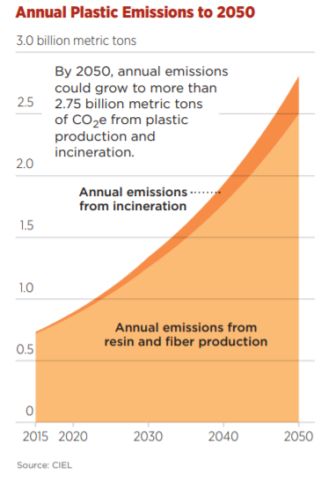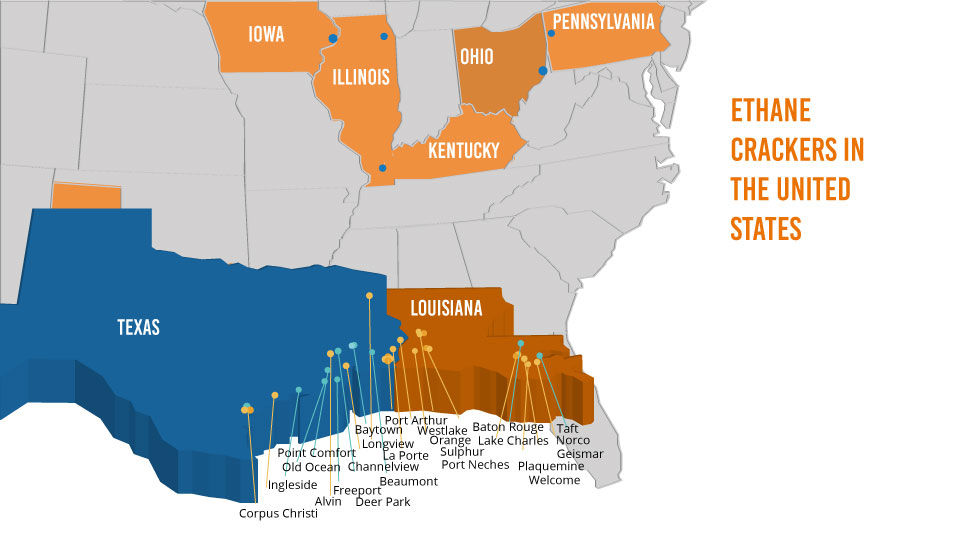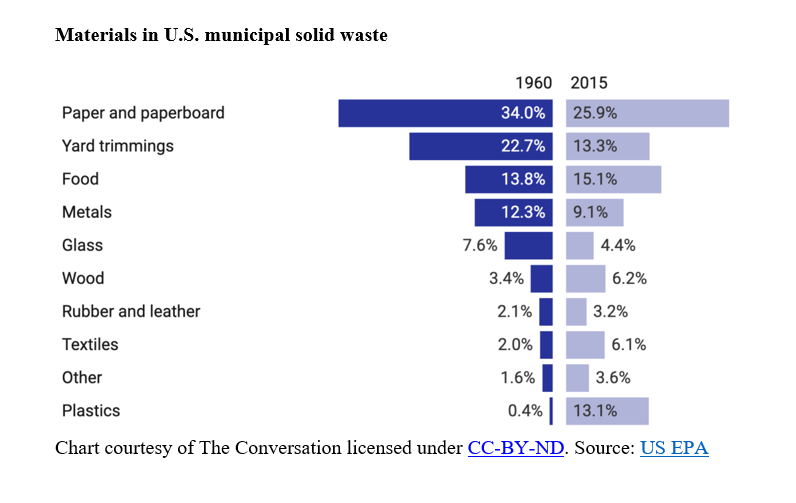Plastic is ubiquitous, filling stores, overtopping landfills and littering shorelines.
It’s even within us, since residual plastic particles now lace air, water and food. While the hazards posed by microplastics are still emerging, an obvious peril has been hiding in plain sight: Plastic derives from fossil fuels, and worsens climate threats throughout its life cycle.
Look down a supermarket aisle lined with chip bags and soda bottles, and chances are you don’t visualize the flaring gas from a shale drilling operation. That might change if you read “The New Coal: Plastics and Climate Change.”
This report, commissioned by the Vermont-based nonprofit Beyond Plastics, highlights how much greenhouse gas pollution plastics emit — in fossil fuel extraction, manufacturing, incineration, landfills and long-term degradation (potentially spanning centuries).

Source: Center for International Environmental Law
Climate-disrupting emissions from the plastic industry could surpass those from coal production in the U.S. by 2030, the report warns. Given emissions from more than 130 existing facilities, new plants under construction and other industry sources, U.S. plastics could generate the carbon dioxide equivalent of 143 mid-sized coal-fired plants.
Yet policy makers and regulators have largely overlooked plastics. Maine’s 2020 Climate Action Plan, for example, holds virtually no mention of plastics, waste reduction, trash incineration or recycling.
“Massive blind spots in policy at local, state and federal levels have allowed plastics to go under the radar,” said Jim Vallette, president of Maine-based Material Research L3C and author of the recent report.
It’s time to bring plastic’s climate risks into clear view.
Just another form of fossil fuel
Greenhouse gas emissions from global plastics industries stand just behind those of the worst carbon-polluting nations: China, the U.S., India and Russia. At the recent U.N. Climate Summit in Glasgow, Scotland, multinational fossil fuel interests — which include petrochemical and plastics industries — had a stronger presence than any single country, with more than 500 industry representatives (whereas, the U.S. had 165 delegates).
Fossil fuel corporations are pivoting to plastic production to keep afloat, given the existential threat posed by dropping prices of renewable power and increasing electric vehicle adoption. Global plastics production is expected to double by 2040, becoming the biggest growth market for fossil fuel demand, the International Energy Agency (IEA) and BP both forecast.
U.S. plastic production draws primarily on ethane gas from hydraulically fractured shale, an abundant resource since the fracking boom that began in 2008. For the eastern U.S., the federal Department of Energy in 2018 projected a 20-fold increase in ethane production over 2013 levels by 2025.
Toxic manufacturing clusters
Following pipeline transport from fracked wells, ethane gas is steam-heated in “ethane cracker” plants until it breaks into new molecules, forming the ethylene used in plastic manufacturing. This energy-intensive process generates high levels of carbon dioxide, and pollutants such as volatile organic compounds and benzene.

Credit: Beyond Plastics
Most plastic manufacturing occurs near the Gulf of Mexico in Texas and along Louisiana’s “Cancer Alley,” a region notorious for its high and growing concentration of petrochemical plants.
The New Coal report found that more than 90 percent of climate pollution reported to the U.S. Environmental Protection Agency (EPA) by the plastics industry is released into 18 communities, noting that “people living within three miles of these petrochemical clusters earn 28 percent less than the average U.S. household and are 67 percent more likely to be people of color.”
The world’s largest ethane cracker plant, a joint venture between ExxonMobil and Saudi Arabia’s state-owned petroleum corporation, is nearing completion outside Portland, Texas. Sprawling across a 1,300-acre site, the plant lies less than two miles from area schools and in full view of a low-income housing complex. Communities have fought against these facilities but with limited success.
The myth of plastic recycling
Many of the ethane cracker plants being built will produce single-use plastics such as bottles, sachets and straws. Plastic items often bear recycling symbols, but few actually get recycled. The latest EPA data from 2018 indicates that fewer than 9 percent of plastics were recycled, while 17 percent were incinerated and 69 percent were landfilled.
At least 115 towns in Maine currently lack any recycling option, with all household waste either landfilled or incinerated. Maine has three municipal waste incinerators operating: in Portland, Auburn and Orrington. Each was built decades ago, when plastic represented roughly 10 percent of the waste stream. That figure has nearly doubled, Vallette said.
Higher plastic content adds to the carbon dioxide incinerators emit, and can introduce chemicals that are potent warming agents. Vallette has calculated that fluoropolymers, highly persistent PFAS resins used in wiring insulation, may have up to 10,000 times more potential for global warming than carbon dioxide.
Petrochemical corporations have misled consumers for decades by promoting plastic recycling while knowing it was not feasible. The industry also ran repeated ad campaigns to convince consumers that the problem was not with plastic itself, but with irresponsible litterbugs.
Changes in Maine, Oregon
Now consumers have caught on. States like Maine and Oregon are taking a new regulatory approach that holds producers responsible for the packaging they produce.
Maine’s pioneering Extended Producer Responsibility (EPR) law will drastically cut the plastic industry’s “greenwashing capability,” observed Sarah Nichols, Sustainable Maine program director for the Natural Resources Council of Maine. “We’re going to finally get the data we need to make meaningful change. It’s a whole new system.”
Similar programs in other countries have increased recycling rates and reduced waste generation — two measures that could markedly cut Maine’s greenhouse gas emissions.
 Maine has never met its statutory goal for recycling, set in 1989, of 50 percent. Today, only about 36 percent of waste is even collected for recycling (and the percentage getting recycled is likely much less). If the state met its original goal, Nichols estimates, the reduction in carbon pollution would be equivalent to taking roughly 166,000 passenger cars off the road.
Maine has never met its statutory goal for recycling, set in 1989, of 50 percent. Today, only about 36 percent of waste is even collected for recycling (and the percentage getting recycled is likely much less). If the state met its original goal, Nichols estimates, the reduction in carbon pollution would be equivalent to taking roughly 166,000 passenger cars off the road.
Action at all levels — from local to global
“The inevitable, logical next step,” Vallette observed, “is to minimize plastic entering the waste stream.”
Purchasing less plastic, supporting retailers that offer bulk and refillable goods, instituting bans (like Maine’s recent one on single-use plastic bags) and holding producers to account through EPR laws should help. The state also needs to address plastics in the ongoing work of the Maine Climate Council, compensating for the notable absence of waste reduction targets in the 2020 Climate Action Plan.
A federal EPR bill, the Break Free from Plastic Pollution Act, has garnered more than 100 co-sponsors already, but given the power of the plastics lobby, its passage is far from assured. Among Maine’s delegation, only U.S. Rep. Chellie Pingree has cosponsored the legislation to date.
Congress must also reassess billions of dollars in federal subsidies going annually to the fossil fuel industry. According to a 2020 report by the research nonprofit Carbon Tracker, the global plastics industry receives $12 billion in subsidies annually while paying just $2 billion in taxes and racking up an estimated $350 billion a year in unpaid “externalities” — including marine debris, air pollution and greenhouse gas emissions.
“In the next few years,” the IEA wrote in a report earlier this year, “all governments need to eliminate fossil fuel subsidies.”

